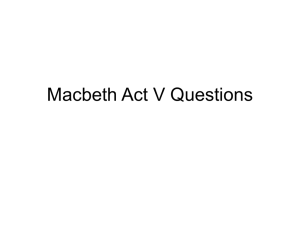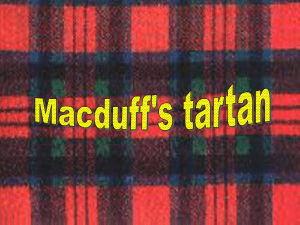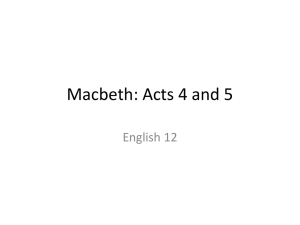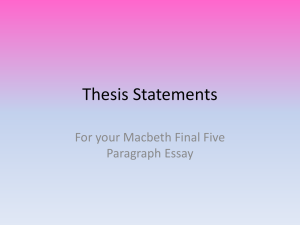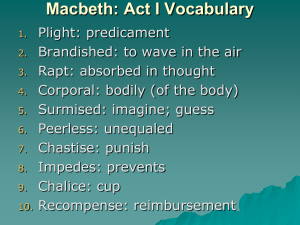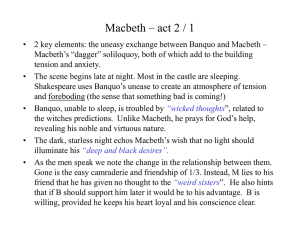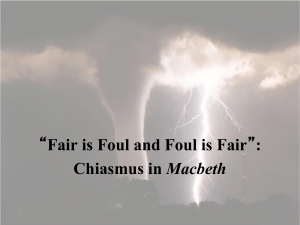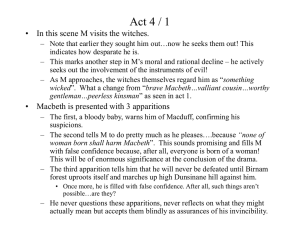Grade 10 ELA Module 4, Unit 2, Lesson 13
advertisement
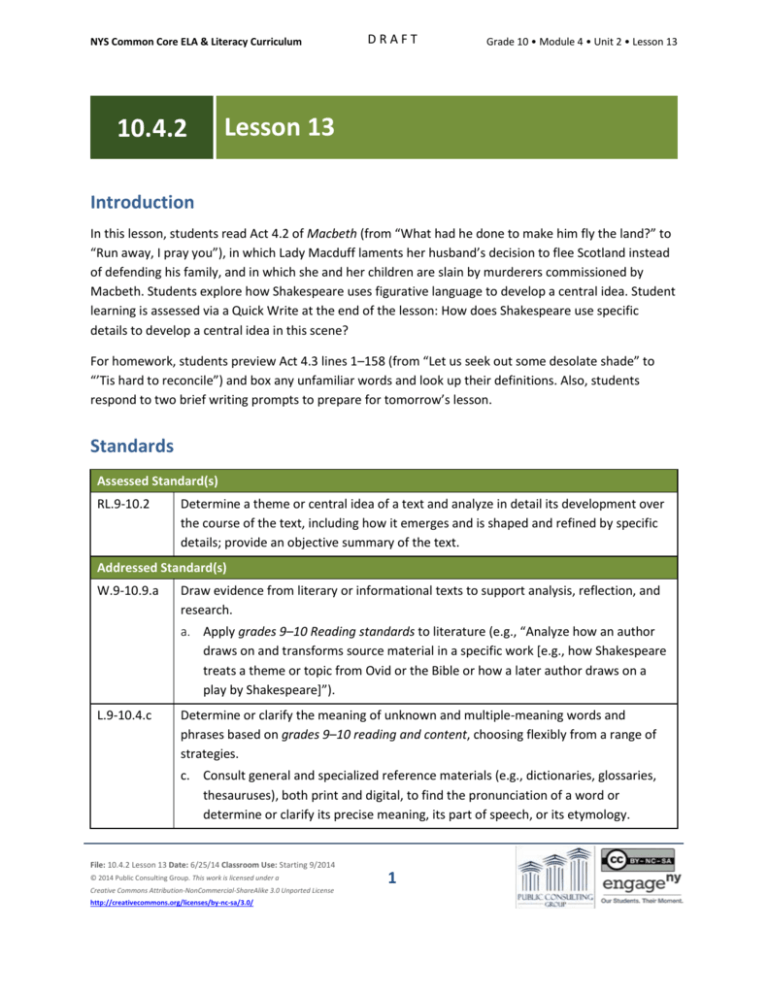
NYS Common Core ELA & Literacy Curriculum 10.4.2 DRAFT Grade 10 • Module 4 • Unit 2 • Lesson 13 Lesson 13 Introduction In this lesson, students read Act 4.2 of Macbeth (from “What had he done to make him fly the land?” to “Run away, I pray you”), in which Lady Macduff laments her husband’s decision to flee Scotland instead of defending his family, and in which she and her children are slain by murderers commissioned by Macbeth. Students explore how Shakespeare uses figurative language to develop a central idea. Student learning is assessed via a Quick Write at the end of the lesson: How does Shakespeare use specific details to develop a central idea in this scene? For homework, students preview Act 4.3 lines 1–158 (from “Let us seek out some desolate shade” to “’Tis hard to reconcile”) and box any unfamiliar words and look up their definitions. Also, students respond to two brief writing prompts to prepare for tomorrow’s lesson. Standards Assessed Standard(s) RL.9-10.2 Determine a theme or central idea of a text and analyze in detail its development over the course of the text, including how it emerges and is shaped and refined by specific details; provide an objective summary of the text. Addressed Standard(s) W.9-10.9.a Draw evidence from literary or informational texts to support analysis, reflection, and research. a. Apply grades 9–10 Reading standards to literature (e.g., “Analyze how an author draws on and transforms source material in a specific work [e.g., how Shakespeare treats a theme or topic from Ovid or the Bible or how a later author draws on a play by Shakespeare]”). L.9-10.4.c Determine or clarify the meaning of unknown and multiple-meaning words and phrases based on grades 9–10 reading and content, choosing flexibly from a range of strategies. c. Consult general and specialized reference materials (e.g., dictionaries, glossaries, thesauruses), both print and digital, to find the pronunciation of a word or determine or clarify its precise meaning, its part of speech, or its etymology. File: 10.4.2 Lesson 13 Date: 6/25/14 Classroom Use: Starting 9/2014 © 2014 Public Consulting Group. This work is licensed under a Creative Commons Attribution-NonCommercial-ShareAlike 3.0 Unported License http://creativecommons.org/licenses/by-nc-sa/3.0/ 1 NYS Common Core ELA & Literacy Curriculum L.9-10.5.a DRAFT Grade 10 • Module 4 • Unit 2 • Lesson 13 Demonstrate understanding of figurative language, word relationships, and nuances in word meanings. a. Interpret figures of speech (e.g., euphemism, oxymoron) in context and analyze their role in the text. Assessment Assessment(s) Student learning is assessed via a Quick Write at the end of the lesson. Students respond to the following prompt, citing textual evidence to support analysis and inferences drawn from the text. How does Shakespeare use specific details to develop a central idea in this scene? High Performance Response(s) A High Performance Response should: Cite a central idea in the text (e.g., imbalance or disorder, appearance versus reality, etc.). Cite specific details (e.g., Lady Macduff describing Macduff as, “wanting the natural touch” (line 11), the son’s murder at the end of the scene, etc.). Analyze how those specific details develop a central idea in this scene (e.g., Shakespeare develops the central idea of disorder when Lady Macduff describes Macduff using the image of the wren, “the most diminutive of birds” (line 12), to depict Macduff’s failure to defend his family. Lady Macduff suggests that Macduff is acting against nature because even the tiny wren will stay to defend his nest). Vocabulary Vocabulary to provide directly (will not include extended instruction) diminutive (adj.) – tiny judicious (adj.) – having good judgment laudable (adj.) – deserving praise prattler (n.) – someone who talks in a foolish or simple-minded way treachery (n.) – betrayal of trust unsanctified (adj.) – unholy File: 10.4.2 Lesson 13 Date: 6/25/14 Classroom Use: Starting 9/2014 © 2014 Public Consulting Group. This work is licensed under a Creative Commons Attribution-NonCommercial-ShareAlike 3.0 Unported License http://creativecommons.org/licenses/by-nc-sa/3.0/ 2 NYS Common Core ELA & Literacy Curriculum DRAFT Grade 10 • Module 4 • Unit 2 • Lesson 13 Vocabulary to teach (may include direct word work and/or questions) wit (n.) – intelligence nearly (adv.) – very soon; very near homely (adj.) – plain Additional vocabulary to support English Language Learners (to provide directly) bird (n.) – an animal that has wings and is covered with feathers* thou’dst (contr.) – you could *Consider providing students with visual aids to support understanding of this definition. Lesson Agenda/Overview Student-Facing Agenda % of Lesson Standards & Text: Standards: RL.9-10.2, W.9-10.9.a, L.9-10.4.c, L.9-10.5.a Text: Macbeth by William Shakespeare, Act 4.2 Learning Sequence: 1. 2. 3. 4. 5. Introduction of Lesson Agenda Homework Accountability Reading and Discussion Quick Write Closing 1. 2. 3. 4. 5. Materials Student copies of the Short Response Rubric and Checklist (refer to 10.4.1 Lesson 1) Learning Sequence How to Use the Learning Sequence Symbol Type of Text & Interpretation of the Symbol 10% no symbol Percentage indicates the percentage of lesson time each activity should take. Plain text indicates teacher action. Bold text indicates questions for the teacher to ask students. File: 10.4.2 Lesson 13 Date: 6/25/14 Classroom Use: Starting 9/2014 © 2014 Public Consulting Group. This work is licensed under a Creative Commons Attribution-NonCommercial-ShareAlike 3.0 Unported License http://creativecommons.org/licenses/by-nc-sa/3.0/ 3 5% 20% 55% 15% 5% NYS Common Core ELA & Literacy Curriculum DRAFT Grade 10 • Module 4 • Unit 2 • Lesson 13 Italicized text indicates a vocabulary word. Indicates student action(s). Indicates possible student response(s) to teacher questions. Indicates instructional notes for the teacher. Activity 1: Introduction of Lesson Agenda 5% Begin by reviewing the agenda and the assessed standard for this lesson: RL.9-10.2. In this lesson, students analyze how Shakespeare uses specific details to develop a central idea in this scene. Students engage in evidence-based discussion as well as complete a brief writing assignment to close the lesson. Students look at the agenda. Activity 2: Homework Accountability 20% Instruct students to Turn-and-Talk about their Lesson 12 homework (Review all notes and annotations you made while reading Act 3 and then record a summary of the act and analysis of character and central idea development on the Act Synopsis and Analysis Tool). See the Model Act Synopsis and Analysis Tool at the end of this lesson for sample student responses. Lead a brief, whole-class discussion of student responses. Activity 3: Reading and Discussion 55% Instruct students to form the small groups they established in 10.4.2 Lesson 1 and read aloud Act 4.2, lines 1–34 (from “What had he done to make him fly the land?” to “I take my leave at once”), each student reading a different role. Post or project the following questions for students to answer in their groups before sharing out with the class. If necessary to support comprehension and fluency, consider having students listen to a masterful reading of Act 4.2. Differentiation Consideration: Consider posting or projecting the following guiding question to support students in their reading throughout this lesson: What is a central idea in this scene? Provide students with the following definitions: diminutive means “tiny” and judicious means “having good judgment.” File: 10.4.2 Lesson 13 Date: 6/25/14 Classroom Use: Starting 9/2014 © 2014 Public Consulting Group. This work is licensed under a Creative Commons Attribution-NonCommercial-ShareAlike 3.0 Unported License http://creativecommons.org/licenses/by-nc-sa/3.0/ 4 NYS Common Core ELA & Literacy Curriculum DRAFT Grade 10 • Module 4 • Unit 2 • Lesson 13 Students may be familiar with some of these words. Consider asking students to volunteer definitions before providing them to the class. Students write the definitions of diminutive and judicious on their copy of the text or in their vocabulary journals. Consider reminding students throughout to use the explanatory notes to help with challenging language. Students may need the scaffolding in the notes to make meaning of certain difficult phrases or archaic language. Differentiation Consideration: Consider providing students a visual for bird and the following definition: bird means “an animal that has wings and is covered with feathers.” Students write the definition of bird on their copy of the text or in a vocabulary journal. What words or phrases develop your understanding of how Lady Macduff feels about Macduff? Student responses may include: o o o “Fly” (line 10) and “traitors” (line 5) show that she thinks he is fleeing because he is scared and a traitor. The phrase “He wants the natural touch” (line 11) shows that she thinks he is acting unnaturally, not like a normal, loving husband or father. All of these words show that Lady Macduff is angry with Macduff for leaving them. What metaphor does Lady Macduff use to illustrate Macduff’s “madness” (line 4)? Lady Macduff contrasts Macduff with “the most of diminutive birds, [that] will fight” to demonstrate her frustration with Macduff for leaving her and her children defenseless. Differentiation Consideration: Consider reminding students of their work with metaphors in 10.4.1 Lesson 1. If necessary, define metaphor as “a figure of speech that describes a person or object by asserting that he/she/it is the same as another otherwise unrelated object.” Consider drawing students’ attention to their application of standard L.9-10.5.a through the process of interpreting figurative language. How does this figurative language develop a central idea in this scene? It develops the central idea of disorder by showing Macduff’s lacking the “natural touch” to defend his family, which even a “poor wren, / The most diminutive of birds” (lines 11–12) has the instinct to do. Consider drawing students’ attention to their application of standard L.9-10.5.a through the process of interpreting figurative language. File: 10.4.2 Lesson 13 Date: 6/25/14 Classroom Use: Starting 9/2014 © 2014 Public Consulting Group. This work is licensed under a Creative Commons Attribution-NonCommercial-ShareAlike 3.0 Unported License http://creativecommons.org/licenses/by-nc-sa/3.0/ 5 NYS Common Core ELA & Literacy Curriculum DRAFT Grade 10 • Module 4 • Unit 2 • Lesson 13 If students struggle, consider asking the following questions: To what does Lady Macduff compare Macduff? Lady Macduff compares him to the “poor wren” (line 11). What is Lady Macduff suggesting by the comparison? Lady Macduff suggests that Macduff does not have the courage of even “[t]he most diminutive of birds” (line 12) to defend his family. How does this develop the central idea of disorder? It demonstrates how Macduff lacks “the natural touch” (line 11), or natural instinct that even the weakest of animals has to defend his family, and how that breaks from the natural instinct of most parents. How does Ross’s response to Lady Macduff develop a central idea? Ross’s response develops the central idea of appearance vs. reality when he says, “But cruel are the times when we are traitors / And do not know ourselves” (lines 22–23), because he means that Macduff may not think he is a traitor, but he appears to be one. Lead a brief whole-class discussion of student responses. Remind students to annotate their texts for central idea, using the code CI. Remind students that annotating helps them keep track of evidence they will be using later in lesson assessments and the Performance Assessment, which focus on the development of central ideas. This focused annotation supports students’ engagement with W.9-10.9.a, which addresses the use of textual evidence in writing. Instruct student groups to read aloud Act 4.2, lines 35–70 (from “Sirrah, your father’s dead” to “Poor prattler, how thou talk’st!”), each student reading a different role. Then groups answer the following questions before sharing out with the class. Provide students with the following definitions: prattler means “someone who talks in a foolish or simple-minded way” and wit means “intelligence.” Students may be familiar with some of these words. Consider asking students to volunteer definitions before providing them to the class. Students write the definitions of prattler and wit onto their copy of the text or into their vocabulary journals. File: 10.4.2 Lesson 13 Date: 6/25/14 Classroom Use: Starting 9/2014 © 2014 Public Consulting Group. This work is licensed under a Creative Commons Attribution-NonCommercial-ShareAlike 3.0 Unported License http://creativecommons.org/licenses/by-nc-sa/3.0/ 6 NYS Common Core ELA & Literacy Curriculum DRAFT Grade 10 • Module 4 • Unit 2 • Lesson 13 Differentiation Consideration: Consider providing students the following definition: thou’dst is a contraction of thou couldst and means “you could.” Students write the definition of thou’dst on their copy of the text or in a vocabulary journal. What does Lady Macduff mean by “Fathered he is, and yet he’s fatherless” (line 31)? Lady Macduff is angry at Macduff for leaving them undefended. So she tells her son that his father is dead (line 35). How does Lady Macduff’s son know that Macduff is not dead? He has heard Ross and Lady Macduff talking not about Macduff’s death, but about “What had [Macduff] done to make him fly the land” (Line 1). How does Shakespeare use figurative language to further develop Lady Macduff and her son’s feelings in this scene? Shakespeare continues to uses the extended metaphor of birds. Lady Macduff calls her son “Poor bird” (line 40) to express her son’s lack of concern, demonstrated by his statement that “With what I get, I mean; and so do they” (line 39). The metaphor is used again when Lady Macduff believes that her son is not concerned enough: “Poor bird, thou’dst never fear the net nor lime, / The pitfall nor the gin” (lines 40–41), meaning her son does not know enough to be concerned. If necessary, explain to students that an “extended metaphor” is when an author extends a single metaphor or analogy at length through multiple situations in a text. Consider drawing students’ attention to their application of standard L.9-10.5.a through the process of interpreting figurative language. Lead a brief whole-class discussion of student responses. Instruct student groups to read aloud Act 4.2, lines 71–97 (from “Bless you, fair dame. I am not known to you” to “Run away, I pray you”), each student reading a different role. Then groups answer the following questions before sharing out with the class. Provide the following definitions: laudable means “deserving praise,” treachery means “betrayal of trust,” and unsanctified means “unholy.” Students may be familiar with some of these words. Consider asking students to volunteer definitions before providing them to the class. File: 10.4.2 Lesson 13 Date: 6/25/14 Classroom Use: Starting 9/2014 © 2014 Public Consulting Group. This work is licensed under a Creative Commons Attribution-NonCommercial-ShareAlike 3.0 Unported License http://creativecommons.org/licenses/by-nc-sa/3.0/ 7 NYS Common Core ELA & Literacy Curriculum DRAFT Grade 10 • Module 4 • Unit 2 • Lesson 13 Students write the definitions of laudable, treachery, and unsanctified on their copy of the text or in their vocabulary journals. Direct students to the explanatory notes for definitions of the words nearly and homely. What news does the Messenger have for Lady Macduff? Lady Macduff must leave immediately because “danger does approach [her] nearly” (line 73). Paraphrase Lady Macduff’s response to the Messenger. “Why should I run? I have not hurt anyone. But I remember that I am in a world where doing wrong is praised and doing good is punishable. Why then does it even matter if I say I have not hurt anyone?” How does the murder of Lady Macduff and her son develop a central idea in this scene? Student responses may include: o o The events of this scene develop the central idea of disorder because children should not be murdered and die before their parents. The events of this scene develop a central idea of disorder because people who have done no wrong, like Lady Macduff and her son, should not be punished. Lead a brief whole-class discussion of student responses. Remind students to annotate their texts for central idea, using the code CI. Activity 4: Quick Write 15% Instruct students to respond briefly in writing to the following prompt: How does Shakespeare use specific details to develop a central idea in this scene? Instruct students to look at their annotations to find evidence. Ask students to use this lesson’s vocabulary wherever possible in their written responses. Remind students to use the Short Response Rubric and Checklist to guide their written responses. Students listen and read the Quick Write prompt. Display the prompt for students to see, or provide the prompt in hard copy. Transition to the independent Quick Write. Students independently answer the prompt, using evidence from the text. File: 10.4.2 Lesson 13 Date: 6/25/14 Classroom Use: Starting 9/2014 © 2014 Public Consulting Group. This work is licensed under a Creative Commons Attribution-NonCommercial-ShareAlike 3.0 Unported License http://creativecommons.org/licenses/by-nc-sa/3.0/ 8 NYS Common Core ELA & Literacy Curriculum DRAFT Grade 10 • Module 4 • Unit 2 • Lesson 13 See the High Performance Response at the beginning of this lesson. Activity 5: Closing 5% Display and distribute the homework assignment. For homework, instruct students to preview Act 4.3, lines 1–158 (from “Let us seek out some desolate shade” to “’Tis hard to reconcile”) and box any unfamiliar words and look up their definitions in either the explanatory notes or a dictionary. Instruct students to choose the definition that makes the most sense in the context, and write a brief definition above or near the word in the text. Additionally, instruct students to respond to the following prompts in writing: What words or phrases does Macduff use to describe Macbeth? What words or phrases does Malcolm use to describe Macbeth? Students follow along. Homework Preview Act 4.3, lines 1–158 (from “Let us seek out some desolate shade” to “’Tis hard to reconcile”). Box any unfamiliar words and look up their definitions in either the explanatory notes or a dictionary. Choose the definition that makes the most sense in the context, and write a brief definition above or near the word in the text. Also, respond to the following prompts in writing: What words or phrases does Macduff use to describe Macbeth? What words or phrases does Malcolm use to describe Macbeth? File: 10.4.2 Lesson 13 Date: 6/25/14 Classroom Use: Starting 9/2014 © 2014 Public Consulting Group. This work is licensed under a Creative Commons Attribution-NonCommercial-ShareAlike 3.0 Unported License http://creativecommons.org/licenses/by-nc-sa/3.0/ 9 DRAFT NYS Common Core ELA & Literacy Curriculum Grade 10 • Module 4 • Unit 2 • Lesson 13 Model Act Synopsis and Analysis Tool This is not an exhaustive list of all the traits, ideas, or evidence. Students are not expected to list all of the examples provided and may come up with additional items to include on this tool, as long as they rely on appropriate text evidence. Name: Class: Date: Act: _3_Summary: In Act 3, Banquo begins to suspect that Macbeth has killed Duncan to become king. In order to prevent Banquo’s sons from becoming king, Macbeth orders the murder of Banquo and Fleance. Banquo is killed, but Fleance escapes. Macbeth and Lady Macbeth are both unhappy and distressed after Duncan’s murder. At a dinner, Macbeth sees Banquo’s ghost, but nobody else does, and Lady Macbeth tries to convince him it is simply his fear. At the end of Act 3, Lennox and a nameless lord discuss politics, and Lennox learns that Macduff has fled to England to seek help in overthrowing Macbeth. Character Development Central Ideas Character Trait Evidence Banquo Suspicion Banquo wonders how Macbeth got everything the Witches promised: “Thou hast it now—king, Cawdor, Glamis, all / …and I fear / Thou hast played’st most foully for’t” (Act 3.1, lines 1–3). Macbeth Paranoia Idea Mortality File: 10.4.2 Lesson 13 Date: 6/25/14 Classroom Use: Starting 9/2014 Creative Commons Attribution-NonCommercial-ShareAlike 3.0 Unported License http://creativecommons.org/licenses/by-nc-sa/3.0/ Macbeth and Lady Macbeth contemplate the consequences of Duncan’s murder: “Better be with the dead, / Whom we, to gain our peace, have sent to peace, / Than on the torture of the mind to lie / In restless ecstasy” (Act 3.2, lines 22–25). In scene 4, Macbeth interacts with Banquo’s ghost after he has him murdered. Macbeth fears that Banquo’s sons, and not himself, will become king, so he arranges for Banquo and Fleance’s murders: “Our fears in Banquo / Stick deep, and in his royalty of nature / Reigns that which would be feared” (Act 3.1, lines 53–55). © 2014 Public Consulting Group. This work is licensed under a Evidence 10 NYS Common Core ELA & Literacy Curriculum Unhappiness Fear/Confusion Lady Macbeth Unhappiness Macbeth is unhappy and stressed after killing Duncan and planning to kill Banquo: “Better be with the dead, / Whom we, to gain our peace, have sent to peace, / Than on the torture of the mind to lie / In restless ecstasy,” (Act 3.2, lines 22–25). DRAFT Appearance vs. Reality Lady Macbeth is, like her husband, unhappy and distressed after helping murder Duncan: “Naught’s had, all’s spent, / Where our desire is got without content. / ’Tis safer to be that which we destroy / Than by destruction dwell in doubtful joy” (Act 3.2, lines 6–10). File: 10.4.2 Lesson 13 Date: 6/25/14 Classroom Use: Starting 9/2014 Creative Commons Attribution-NonCommercial-ShareAlike 3.0 Unported License http://creativecommons.org/licenses/by-nc-sa/3.0/ Macbeth convinces Banquo’s murderers to kill him by telling them that Banquo is an enemy: “Both of you / Know Banquo was your enemy,” (Act 3.1, lines 129–130). Macbeth sees a ghost, but nobody else does, and Lady Macbeth mocks him for it: “LM: Are you a man? / M: Ay, and a bold one, that dare look on that / Which might appall the devil” (Act 3.4, lines 70–72). After killing Banquo, Macbeth is scared and confused by his ghost: “Ay, and a bold one, that dare look on that / Which might appall the devil” (Act 3.4, lines 70–72) and “Hence, horrible shadow!” (Act 3.4, line 128). © 2014 Public Consulting Group. This work is licensed under a Grade 10 • Module 4 • Unit 2 • Lesson 13 11
